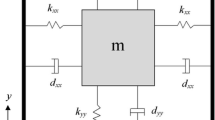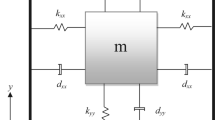Abstract
Data-driven control methods are strong tools due to their predictions for controlling the systems with a nonlinear dynamic model. In this paper, the Koopman operator is used to linearize the nonlinear dynamic model. Generating the Koopman operator is the most important part of using the Koopman theory. Dynamic mode decomposition (DMD) is used to obtain eigenfunction for producing the Koopman operator. Then, a fractional order PID (FOPID) controller is applied to control the linearized dynamic model. A swarm intelligence bat optimization algorithm is utilized to tune the FOPID controller’s parameters. Simulation results on micro-electromechanical systems (MEMS) gyroscope under conventional PID controller, FOPID, Koopman-based FOPID controller (Koopman-FOPID), and Koopman-FOPID control optimized by bat algorithm (Koopman-BAFOPID) show that the proposed Koopman-BAFOPID controller has better performance in comparison with three other controllers in terms of high tracking performance, low tracking error, and low control efforts.








Similar content being viewed by others
Data Availability
Data sharing is not applicable to this article as no datasets were generated or analyzed during the current study.
References
Solouk MR, Shojaeefard MH, Dahmardeh M (2019) Parametric topology optimization of a MEMS gyroscope for automotive applications. Mech Syst Signal Process 128:389–404
Classen, J., Frey, J., Kuhlmann, B., Ernst, P., & Bosch, R. (2007, August). MEMS gyroscopes for automotive applications. In Advanced Microsystems for Automotive Applications (pp. 291–306). Berlin, Germany: Springer.
Zhang WJ, Lin Y (2010) On the principle of design of resilient systems–application to enterprise information systems. Enterprise Information Systems 4(2):99–110
Gao S, Liu L, Wang H, Wang A (2022) Data-driven model-free resilient speed control of an Autonomous Surface Vehicle in the presence of actuator anomalies. ISA Transact 127:251
Xian B, Gu X, Pan X (2022) Data driven adaptive robust attitude control for a small size unmanned helicopter. Mech Syst Signal Process 177:109205
Liu H, Cheng Q, Xiao J, Hao L (2021) Data-driven adaptive integral terminal sliding mode control for uncertain SMA actuators with input saturation and prescribed performance. ISA Transact 128:624
Sun C, Dominguez-Caballero J, Ward R, Ayvar-Soberanis S, Curtis D (2022) Machining cycle time prediction: Data-driven modelling of machine tool feedrate behavior with neural networks. Robotics and Computer-Integrated Manufacturing 75:102293
Chen WH, You F (2021) Semiclosed greenhouse climate control under uncertainty via machine learning and data-driven robust model predictive control. IEEE Trans Control Syst Technol 30(3):1186–1197
Hadian M, Ramezani A, Zhang W (2022) An interpolation-based model predictive controller for input–output linear parameter varying systems. Inter J Dyn Cont 10:1–14
Hadian M, Ramezani A, Zhang W (2021) robust model predictive controller using recurrent neural networks for input-output linear parameter varying systems. Electronics 10(13):1557
Goswami D., and Paley DA (2021). Bilinearization, reachability, and optimal control of control-affine nonlinear systems: A Koopman spectral approach. IEEE Transact Automatic Cont
Bruder D, Fu X, Gillespie RB, Remy CD, Vasudevan R (2020) Data-driven control of soft robots using koopman operator theory. IEEE Trans Rob 37(3):948–961
Zanini F, Chiuso A (2021) Estimating Koopman operators for nonlinear dynamical systems: a nonparametric approach. IFAC-PapersOnLine 54(7):691–696
Jiang L, Liu N (2022) Correcting noisy dynamic mode decomposition with Kalman filters. J Comput Phys 461:111175
Ling E, Zheng, L, Ratliff LJ, & Coogan, S (2020). Koopman operator applications in signalized traffic systems. IEEE Transact Intell Transport Syst
Wilches-Bernal F, Reno MJ, Hernandez-Alvidrez J (2021) A Dynamic Mode Decomposition Scheme to Analyze Power Quality Events. IEEE Access 9:70775–70788
Mamakoukas G, Castano M, Tan X, & Murphey, T (2019). Local Koopman operators for data-driven control of robotic systems. In Robotics: Science and Systems.
Ping Z, Yin Z, Li X, Liu Y, Yang T (2021) Deep Koopman model predictive control for enhancing transient stability in power grids. Int J Robust Nonlinear Control 31(6):1964–1978
Rahmani M, Ghanbari A, Ettefagh MM (2016) Robust adaptive control of a bio-inspired robot manipulator using bat algorithm. Expert Syst Appl 56:164–176
Rahmani M, Komijani H, Ghanbari A, Ettefagh MM (2018) Optimal novel super-twisting PID sliding mode control of a MEMS gyroscope based on multi-objective bat algorithm. Microsyst Technol 24(6):2835–2846
Fei, J., & Chu, Y. (2016, August). Dynamic global PID sliding mode control for MEMS gyroscope using adaptive neural controller. In: 2016 joint 8th international conference on soft computing and intelligent systems (SCIS) and 17th international symposium on advanced intelligent systems (ISIS) (pp. 16–21). IEEE.
Marino R, Scalzi S, Netto M (2011) Nested PID steering control for lane keeping in autonomous vehicles. Control Eng Pract 19(12):1459–1467
Yoon J, Doh J (2022) Optimal PID control for hovering stabilization of quadcopter using long short term memory. Adv Eng Inform 53:101679
Li JW, Chen XB, Zhang WJ (2010) Axiomatic-design-theory-based approach to modeling linear high order system dynamics. IEEE/ASME Trans Mechatron 16(2):341–350
Liu L, Zhang L, Pan G, Zhang S (2022) Robust yaw control of autonomous underwater vehicle based on fractional-order PID controller. Ocean Eng 257:111493
Erol H (2021) Stability analysis of pitch angle control of large wind turbines with fractional order PID controller. Sustainable Energy, Grids and Networks 26:100430
Yang, XS (2010). A new metaheuristic bat-inspired algorithm. In Nature inspired cooperative strategies for optimization (NICSO 2010) (pp. 65-74). Springer, Berlin, Heidelberg
Perwaiz U, Younas I, Anwar AA (2020) Many-objective BAT algorithm. PLoS ONE 15(6):e0234625
Lakshmanaprabu SK, Elhoseny M, Shankar K (2019) Optimal tuning of decentralized fractional order PID controllers for TITO process using equivalent transfer function. Cogn Syst Res 58:292–303
Chaib L, Choucha A, Arif S (2017) Optimal design and tuning of novel fractional order PID power system stabilizer using a new metaheuristic Bat algorithm. Ain Shams Eng J 8(2):113–125
Fang Y, Fu W, Ding H, Fei J (2022) Modeling and neural sliding mode control of mems triaxial gyroscope. Adv Mech Eng 14(3):16878132221085876
Lu C, & Fei J (2016). Adaptive sliding mode control of MEMS gyroscope with prescribed performance. In: 2016 14th international workshop on variable structure systems (VSS) (pp. 65–70). IEEE.
Guo Y, Xu B, Zhang R (2020) Terminal sliding mode control of mems gyroscopes with finite-time learning. IEEE Transact Neural Netw Learn Syst 32(10):4490–4498
Rahmani M, Rahman MH, Nosonovsky M (2020) A new hybrid robust control of MEMS gyroscope. Microsyst Technol 26(3):853–860
Yan W, Hou S, Fang Y, Fei J (2017) Robust adaptive nonsingular terminal sliding mode control of MEMS gyroscope using fuzzy-neural-network compensator. Int J Mach Learn Cybern 8(4):1287–1299
Kaiser E, Kutz JN, Brunton SL (2021) Data-driven discovery of Koopman eigenfunctions for control. Mach Learn: Sci Technol 2(3):035023
Snyder G, & Song Z (2021) Koopman operator theory for nonlinear dynamic modeling using dynamic mode decomposition. arXiv preprint arXiv:2110.08442.
Malarvili S, Mageshwari S (2022) Nonlinear PID (N-PID) controller for SSSP grid connected inverter control of photovoltaic systems. Electric Power Syst Res 211:108175
Guo TY, Lu LS, Lin SY, Hwang C (2022) Design of maximum-stability PID controllers for LTI systems based on a stabilizing-set construction method. J Taiwan Inst Chem Eng 135:104366
Yan L, Webber JL, Mehbodniya A, Moorthy B, Sivamani S, Nazir S, Shabaz M (2022) Distributed optimization of heterogeneous UAV cluster PID controller based on machine learning. Comput Electr Eng 101:108059
Abdelouahab MS, Hamri NE (2016) The Grünwald-Letnikov fractional-order derivative with fixed memory length. Mediterr J Math 13(2):557–572
Yang XS (2012). Bat algorithm for multi-objective optimisation. arXiv preprint arXiv:1203.6571.
Sathya MR, Ansari MMT (2015) Load frequency control using Bat inspired algorithm based dual mode gain scheduling of PI controllers for interconnected power system. Int J Electr Power Energy Syst 64:365–374
Mitić M, Miljković Z (2015) Bio-inspired approach to learning robot motion trajectories and visual control commands. Expert Syst Appl 42(5):2624–2637
Funding
Funding was provide by Directorate for Engineering, National Science Foundation.
Author information
Authors and Affiliations
Corresponding author
Ethics declarations
Conflict of interest
There are no conflicts of interest.
Additional information
Publisher's Note
Springer Nature remains neutral with regard to jurisdictional claims in published maps and institutional affiliations.
Rights and permissions
Springer Nature or its licensor (e.g. a society or other partner) holds exclusive rights to this article under a publishing agreement with the author(s) or other rightsholder(s); author self-archiving of the accepted manuscript version of this article is solely governed by the terms of such publishing agreement and applicable law.
About this article
Cite this article
Rahmani, M., Redkar, S. Data-driven Koopman fractional order PID control of a MEMS gyroscope using bat algorithm. Neural Comput & Applic 35, 9831–9840 (2023). https://doi.org/10.1007/s00521-023-08220-w
Received:
Accepted:
Published:
Issue Date:
DOI: https://doi.org/10.1007/s00521-023-08220-w




